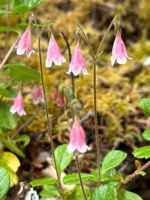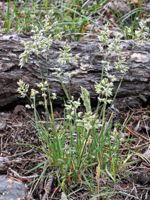Mon-Fri 9am - 5pm Mountain time
Twinflower vs Alpine Bluegrass
Linnaea borealis
Poa alpina
CUSTOM GROW
CUSTOM GROW
Twinflower is a native, trailing evergreen ground cover known for its delicate flowers that grow in nodding pairs. These pale pink blooms are described as being sweetly fragrant, attracting native bees and other pollinators.
Growing in cool, moist, acidic soils, the trailing stems form roots as they spread and start to form mats across the forest floor. Due to its woody stem, it is technically classified as a shrub and often referred to as a subshrub or dwarf shrub. This species is well-suited for naturalization, restoration, and conservation projects.
Twinflower (Linneae borealis) was named in honour of Carl Linnaeus, who adopted it as his personal emblem.
Alpine Bluegrass is a native perennial bunchgrass adapted to cold, high-altitude, and northern environments. It establishes well in harsh mountain and tundra conditions, thriving even in nutrient-poor soils. Its dense tufts provide reliable ground cover in alpine and subalpine habitats.
Hardy and low-maintenance, Alpine Bluegrass is valued in revegetation and erosion control projects due to its strong root system. It provides forage for wildlife and livestock, while its dense growth also offers cover for small animals. Well-suited for reclamation and soil stabilization in high-elevation and northern regions, Alpine Bluegrass is a key species for strengthening fragile landscapes, though it is also found in lower-elevation sites.

